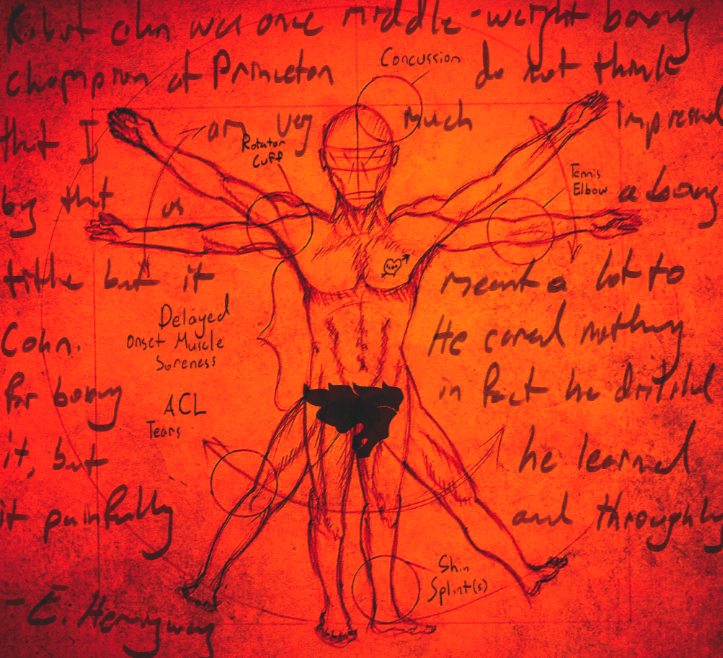Common sports injuries
Sofia Hashi | Fulcrum Staff
Illustration by Mathias MacPhee
THEY’RE AS INEVITABLE as the final whistle blowing: injuries in sports. All athletes, professional or recreational, risk injuries when they’re training or playing on the field. Certain maladies are more common than others. Who can forget about the Sidney Crosby concussion saga of last year? Or how about those career-ending ACL tears we always hear about? Some other injuries aren’t as well known, but affect athletes all the time—delayed onset muscle soreness, anyone? The Fulcrum decided to look at some of the sports injuries that could be holding back your favourite athlete right now.
A) Concussions
The term concussion derives from the Latin word concutere, which means to shake violently. Yikes—no wonder this injury is taken seriously in the sports world. Essentially, a concussion is a form of a traumatic brain injury resulting from a blow to the head. Concussions vary in degree of severity, but all manifest similar physical and cognitive symptoms. Usually those suffering from concussions do make a full recovery and are prescribed the best medicine out there: time and rest. If you think you have a concussion, don’t assume it will go away on its own—this is definitely the kind of thing you want to get checked out.
B) ACL tears
ACL stands for anterior cruciate ligament—thank God for acronyms, eh? An injury to this area of the body can be debilitating to an athlete’s career. The ACL is one of the four major muscle ligaments in the knee, and ACL tears are almost exclusively sports-related. ACL tears are also non-contact, meaning they usually occur when an athlete falls down or pivots irregularly on their knee, resulting in an unstable joint. Depending on the severity of the injury, surgery may be required.
C) Rotator cuff injuries
Composed of muscles and tendons, the rotator cuff gives the shoulder joint a wide range of motion. Connecting the upper arm to the shoulder blade, the rotator cuff also helps stabilize the shoulder. Damage to this area of the body results in limited mobility and pain in the shoulder, especially when reaching overhead. Rotator cuff injuries are usually sustained from repetitive overhead movements or from falling down.
D) Shin splints
The medical term for shin splints is medial tibial stress syndrome. Although athletes may suffer from shin splints, anyone can have a nasty run-in—no pun intended—with such an injury. More common in activities that have sudden and extreme stops and starts, like soccer and football, shin splints occur when there’s too much force placed on the muscle tissue in the lower leg. Swelling and pain in the lower leg are often signs of a shin splint. This injury can usually be treated with rest, ice, and over-the-counter medications.
E) Tennis elbow
Lateral epicondylitis, otherwise known as tennis elbow, refers to the pain that is developed in the elbow joint due to overuse. Tiny tears form in the tendons that join to the forearm and surround the outside area of the elbow, which leads to inflammation and pain. Racket sports are the most common culprits of this ailment, but other activities that require frequent use of this part of the body can also cause such an injury.
F) Delayed onset muscle soreness
Technically not an injury, this ache arises usually 24 to 72 hours after extreme physical exertion. Consisting of tenderness and some mild pain, delayed onset muscle soreness (DOMS) is exactly what it sounds like. DOMS often occurs when someone is new to exercise or sports, but usually decreases over time as their body builds up its tolerance to physical exertion.



